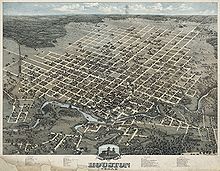In August 1836, two real estate entrepreneurs from New York City, purchased 6,642 acres (26.88 km2) of land along Buffalo Bayouwith the intent of founding a city. The Allen brothers decided to name the city after Sam Houston, the popular general at the Battle of San Jacinto, who was elected President of Texas in September 1836.
Houston was granted incorporation on June 5, 1837, with James S. Holman becoming its first mayor. In the same year, Houston became the county seat of Harrisburg County (now Harris County) and the temporary capital of the Republic of Texas.In 1840, the community established a chamber of commerce in part to promote shipping and waterborne business at the newly created port on Buffalo Bayou.
By 1860, Houston had emerged as a commercial and railroad hub for the export of cotton. Railroad spurs from the Texas inland converged in Houston, where they met rail lines to the ports of Galveston and Beaumont. During the American Civil War, Houston served as a headquarters for General John Bankhead Magruder, who used the city as an organization point for the Battle of Galveston. After the Civil War, Houston businessmen initiated efforts to widen the city's extensive system of bayous so the city could accept more commerce between downtown and the nearby port of Galveston. By 1890, Houston was the railroad center of Texas.
In 1900, after Galveston was struck by a devastating hurricane, efforts to make Houston into a viable deepwater port were accelerated. The following year, oil discovered at the Spindletop oil field near Beaumont prompted the development of the Texas petroleum industry. In 1902, President Theodore Roosevelt approved a $1 million improvement project for the Houston Ship Channel. By 1910 the city's population had reached 78,800, almost doubling from a decade before. An integral part of the city were African Americans, who numbered 23,929 or nearly one-third of the residents. They were developing a strong professional class based then in the Fourth Ward.
President Woodrow Wilson opened the deepwater Port of Houston in 1914, seven years after digging began. By 1930, Houston had become Texas's most populous city and Harris the most populous county.
When World War II started, tonnage levels at the port decreased and shipping activities were suspended; however, the war did provide economic benefits for the city. Petrochemical refineries and manufacturing plants were constructed along the ship channel because of the demand for petroleum and synthetic rubber products during the war. Ellington Field, initially built during World War I, was revitalized as an advanced training center for bombardiers and navigators. The M. D. Anderson Foundation formed the Texas Medical Center in 1945. After the war, Houston's economy reverted to being primarily port-driven. In 1948, several unincorporated areas were annexed into the city limits, which more than doubled the city's size, and Houston proper began to spread across the region.
In 1950, the availability of air conditioning provided impetus for many companies to relocate to Houston resulting in an economic boom and producing a key shift in the city's economy toward the energy sector.
The increased production of the local shipbuilding industry during World War II spurred Houston's growth, as did the establishment in 1961 of NASA's "Manned Spacecraft Center" (renamed the Lyndon B. Johnson Space Center in 1973), which created the city's aerospace industry. The Astrodome, nicknamed the "Eighth Wonder of the World", opened in 1965 as the world's first indoor domed sports stadium.
During the late 1970s, Houston experienced a population boom as people from Rust Belt states moved to Texas in large numbers. The new residents came for the numerous employment opportunities in the petroleum industry, created as a result of the Arab Oil Embargo.
The population boom ended abruptly in the mid-1980s, as oil prices fell precipitously. The space industry also suffered in 1986 after the Space Shuttle Challengerdisintegrated shortly after launch. The late 1980s saw a recession adversely affecting the city's economy.
Since the 1990s, as a result of the recession, Houston has made efforts to diversify its economy by focusing on aerospace and health care/biotechnology and by reducing its dependence on the petroleum industry. In 1997, Houstonians elected Lee P. Brown as the city's first African American mayor.
In June 2001, Tropical Storm Allison dumped up to 40 inches (1,000 mm) of rain on parts of Houston, causing the worst flooding in the city's history; the storm cost billions of dollars in damage and killed 20 people in Texas. By December of that same year, Houston-based energy company Enron collapsed into the third-largest ever U.S. bankruptcy during an investigation surrounding fabricated partnerships that were allegedly used to hide debt and inflate profits.
In August 2005, Houston became a shelter to more than 150,000 people from New Orleans who evacuated from Hurricane Katrina. One month later, approximately 2.5 million Houston area residents evacuated when Hurricane Rita approached the Gulf Coast, leaving little damage to the Houston area. This was the largest urban evacuation in the history of the United States.





No comments:
Post a Comment